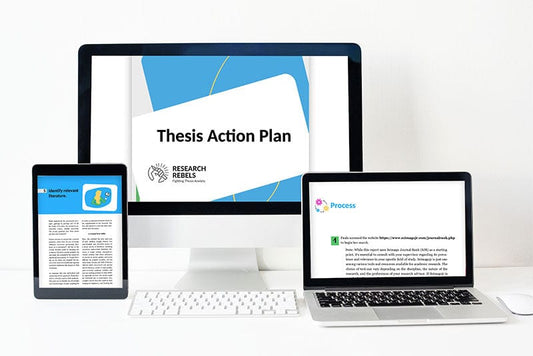How to Write a Thesis in 1 Month: 30 Days to Scholarly Success

Writing a thesis in just one month sounds like a tall order, but with the right approach, it's totally possible. This guide is all about breaking things down into manageable steps, so you can stay on track without losing your mind. Whether you're juggling other responsibilities or just trying to beat the clock, these tips will help you tackle each part of the process with confidence. Let’s dive into how to write a thesis in 1 month and make those 30 days count.
Key Takeaways
- Plan your 30 days with clear, daily goals to stay organized.
- Focus on credible sources and keep your research notes tidy.
- Outline your thesis structure early to ensure a smooth writing process.
- Write consistently every day, even if it’s just a little.
- Don’t skip proofreading—polish your work before submission.
Crafting a Manageable Thesis Timeline
Breaking Down the 30-Day Plan
Writing a thesis in just 30 days might sound impossible, but it’s all about breaking it into smaller, manageable chunks. Start by dividing the month into three phases: research, writing, and refining. Each phase should have specific tasks, such as gathering sources, drafting chapters, and final proofreading. The key is to focus on one task at a time—trying to juggle everything at once can lead to burnout. For example:
- Days 1–10: Focus on research and organizing your notes.
- Days 11–20: Dedicate this time to drafting each section of your thesis.
- Days 21–30: Polish your work, proofread, and make final adjustments.
Setting Realistic Daily Goals
Consistency is your best friend during this process. Instead of aiming for perfection, set achievable daily goals. For instance, aim to write 500 words per day or complete one sub-section. Use a simple table to track your progress:
| Day | Task | Status |
|---|---|---|
| Day 1 | Outline introduction | In Progress |
| Day 2 | Draft methodology | Completed |
| Day 3 | Review literature | Not Started |
This method keeps you accountable and provides a clear snapshot of your achievements.
Prioritizing Key Milestones
Not all tasks are created equal. Identify the milestones that will move you closer to completion, such as finalizing your research question or completing your first draft. Allocate more time to these critical tasks and less to smaller, less impactful ones. A good rule of thumb is to spend 70% of your time on writing and 30% on editing and formatting. Remember, a well-structured timeline is your roadmap to staying on track and avoiding last-minute panic.
For more structured guidance, consider exploring strategies for completing a thesis in 30 days. These resources can provide additional tools and insights to help you stay organized and productive.
Mastering the Art of Research Efficiency
Identifying Credible Sources Quickly
When time is tight, knowing where to look for reliable information is half the battle. Instead of aimlessly browsing the internet, focus on academic databases like PubMed, JSTOR, or Google Scholar. These platforms are designed to provide peer-reviewed and high-quality research. A quick tip? Use advanced search filters to narrow down results by date, relevance, or specific keywords. This saves hours of unnecessary scrolling.
Organizing Research Notes Effectively
Once you’ve gathered your sources, the next challenge is keeping track of them. A messy pile of notes can slow you down. Tools like Zotero or EndNote can help organize references and create citations on the fly. For those who prefer a more hands-on approach, a simple table like this can work wonders:
| Source Title | Key Points | Citation Format |
|---|---|---|
| Example Article 1 | Discusses X and Y theories | APA |
| Example Article 2 | Focus on Z methodology | MLA |
This way, you can quickly refer back to what you need without flipping through endless pages of notes.
Avoiding Common Research Pitfalls
Mistakes happen, but some can be avoided with a little preparation. Here are three common traps and how to sidestep them:
- Overloading on Sources: Quality trumps quantity. Stick to a manageable number of references that directly support your thesis.
- Failing to Cross-Check Information: Don’t take a single source at face value. Verify facts by consulting multiple credible studies.
- Ignoring Time Management: Allocate specific chunks of your day to research. Set a timer if you have to—it’s easy to lose hours in a rabbit hole of articles.
By staying focused and methodical, you’ll find that research doesn’t have to be a daunting task. It’s all about working smarter, not harder.
Developing a Strong Thesis Structure
Outlining Chapters and Sections
Creating a clear outline is the backbone of any well-structured thesis. Start by identifying the major chapters your thesis will include, such as Introduction, Literature Review, Methodology, Results, Discussion, and Conclusion. Within each chapter, break it down further into sections that address specific points. For example, the Literature Review might include sub-sections on key theories, gaps in existing research, and your thesis's unique contribution. A detailed outline not only organizes your thoughts but also keeps your writing focused and on track.
Ensuring Logical Flow of Arguments
Your thesis should read like a cohesive argument, not a collection of disconnected ideas. Make sure each section builds on the previous one. For instance, your Methodology chapter should naturally follow from the gaps identified in the Literature Review. Use transitions to guide the reader through your thought process. If you're struggling, consider seeking advice from mentors or even professionals on platforms like LinkedIn, which can connect you with experts in your field.
Balancing Depth and Brevity
Striking the right balance between being thorough and concise can be tricky. Dive deep enough to demonstrate your expertise, but avoid unnecessary details that might overwhelm the reader. A good rule of thumb is to ask, "Does this add value to my argument?" If not, leave it out. You might also find it helpful to create a table summarizing key points for complex sections, which can make your thesis easier to follow.
Writing with Clarity and Precision
Crafting a Compelling Introduction
The introduction sets the tone for your entire thesis. It’s your chance to grab the reader’s attention and provide a clear roadmap of what’s to come. Start with a strong opening sentence—something that sparks curiosity or frames the importance of your research. Then, outline the problem you’re addressing and why it matters. Avoid lengthy background details here; save those for later sections. Your goal is to make the reader want to keep reading. Think of it like an Instagram caption: concise, engaging, and to the point.
Maintaining Academic Tone Throughout
Academic writing doesn’t have to be dry, but it does need to be formal. Avoid slang, contractions, or overly casual phrases. Instead, aim for sentences that are clear and direct. For example, instead of writing, "This study kinda looks at...", say, "This study examines...". Use specific language to convey your ideas, and don’t shy away from technical terms if they’re appropriate. A consistent tone builds credibility and ensures your work is taken seriously.
Editing for Grammar and Style
Editing is where your thesis truly shines. After finishing a draft, take a step back before diving into revisions. Look for common issues like run-on sentences, passive voice, or awkward phrasing. Tools like grammar checkers can help, but don’t rely on them entirely. Read your work aloud to catch errors you might miss otherwise. Create a checklist for editing:
- Check grammar and punctuation.
- Ensure citations are formatted correctly.
- Verify that every sentence adds value to your argument.
Editing isn’t just about fixing mistakes; it’s about refining your voice and making your thesis as polished as possible.
Overcoming Writer’s Block and Staying Motivated
Techniques to Spark Creativity
Writer’s block can feel like hitting a brick wall, but it’s often just a sign that you need to shake things up. Start by changing your surroundings—sometimes working in a new environment, like a library or café, can make all the difference. Another trick? Set a timer for 10 minutes and free-write anything that comes to mind about your thesis topic. This simple exercise can break the mental freeze and get ideas flowing. If all else fails, try discussing your ideas with a friend or even on WhatsApp—a fresh perspective can do wonders.
Building a Supportive Writing Environment
Your workspace plays a huge role in how productive you are. Keep it tidy and make sure it’s stocked with everything you need—pens, notebooks, snacks, and of course, coffee! Avoid distractions by setting your phone to "Do Not Disturb" or using apps that block social media. If you’re someone who thrives on collaboration, create a virtual study group on WhatsApp to stay connected and motivated.
Celebrating Small Wins to Sustain Momentum
Writing a thesis is a marathon, not a sprint. To keep your energy up, celebrate every little milestone. Finished your introduction? Treat yourself to your favorite snack. Completed a full chapter? Take a well-earned break or watch an episode of your favorite show. These small rewards can keep you motivated and remind you that progress—even small steps—is still progress. Remember, staying positive is key to staying productive.
Leveraging Expert Guidance and Resources

Utilizing Online Courses and Tutorials
One of the most effective ways to streamline your thesis-writing process is by taking advantage of online courses and tutorials. These resources often break down the thesis process into manageable steps, ensuring you stay on track without feeling overwhelmed. For example, structured courses might provide daily tasks, helping you focus on specific goals each day. This approach not only simplifies the process but also builds confidence as you check off each completed task. Consistency is key, and these tools are designed to help you maintain it.
Seeking Personalized Feedback
Sometimes, a fresh perspective can make all the difference. Whether it’s from a professor, mentor, or even a peer, personalized feedback helps identify areas for improvement that you might overlook. Consider scheduling regular check-ins with someone who understands your field of study. They can offer insights into your argument structure, research gaps, or even stylistic choices. Feedback isn’t just about critique; it’s about refining your work to make it stronger.
Maximizing the Use of Writing Tools
Writing tools can save you time and improve the quality of your thesis. From grammar checkers to citation managers, these tools handle the small but essential details, so you can focus on the bigger picture. For example, citation managers like Zotero or EndNote can organize your references effortlessly, while grammar tools like Grammarly ensure your writing is polished and professional. Don’t underestimate the value of these tools—they can be game-changers in making your thesis submission-ready.
Ensuring a Polished Final Submission
Conducting Thorough Proofreading
Before you hit "submit," give your thesis a final, detailed read-through. Proofreading isn't just about catching typos; it's about ensuring your arguments are clear and your ideas flow logically. Look for repetitive phrases, awkward sentence structures, and inconsistencies in terminology. Reading your work aloud can help you catch errors that your eyes might skim over.
Adhering to Formatting Guidelines
Every institution has its own formatting requirements, and this is not the step to overlook. Double-check margins, font sizes, spacing, and citation styles. Create a quick checklist to ensure every section—title page, table of contents, references—is formatted correctly. If you're unsure, consult your institution's thesis manual or ask your advisor for clarification.
| Formatting Element | Requirement Example |
|---|---|
| Font Size | 12 pt (Times New Roman) |
| Line Spacing | Double-spaced |
| Margin Size | 1-inch on all sides |
| Citation Style | APA 7th Edition |
Preparing for Feedback and Revisions
Even after submission, feedback is likely. Approach this step with a mindset of improvement, not criticism. Constructive feedback can elevate your work to a higher standard. Organize your notes and responses to feedback systematically—perhaps in a table or a checklist—to ensure you address every point raised by your reviewers. Having a plan in place will make the revision process smoother and less stressful.
To make sure your final submission shines, take a moment to review your work carefully. Check for any mistakes and ensure everything is clear and easy to understand. Don’t forget to ask for feedback from friends or teachers. They can help you spot things you might have missed. Ready to make your submission the best it can be? Visit our website for tips and tools that can help you succeed!
Conclusion
Writing a thesis in just 30 days might sound like a tall order, but with the right plan and a steady approach, it’s absolutely doable. The key is breaking the process into smaller, manageable steps and staying consistent every day. Sure, there will be moments when it feels overwhelming, but remember, you’re not alone in this. With tools, guidance, and a clear roadmap, you can tackle each challenge as it comes. By the end of the month, you’ll not only have a completed thesis but also the satisfaction of knowing you accomplished something incredible. So, take it one day at a time, trust the process, and keep moving forward—you’ve got this!
Frequently Asked Questions
Is it really possible to write a thesis in 30 days?
Yes, with a clear plan and consistent daily effort, completing a thesis in 30 days is achievable. Breaking the process into smaller tasks helps make it manageable.
How much time should I dedicate each day to writing my thesis?
It depends on your schedule, but setting aside 4–6 focused hours daily can make a big difference. Consistency is key to steady progress.
What if I get stuck on a section of my thesis?
If you’re stuck, take a short break, revisit your research, or seek feedback from a mentor or peer. Sometimes, stepping away can help you see things more clearly.
How can I ensure my thesis is well-organized?
Start with an outline to map out your chapters and sections. This will help you maintain a logical flow and ensure your arguments are clear and concise.
What tools can help me during the thesis writing process?
Tools like citation managers, grammar checkers, and project management apps can save time and keep you organized throughout the writing process.
How do I stay motivated over the 30 days?
Set small, achievable goals and celebrate your progress. Creating a positive, distraction-free workspace can also help you stay focused and motivated.
How to Write a Thesis in 1 Month: 30 Days to Scholarly Success

Writing a thesis in just one month sounds like a tall order, but with the right approach, it's totally possible. This guide is all about breaking things down into manageable steps, so you can stay on track without losing your mind. Whether you're juggling other responsibilities or just trying to beat the clock, these tips will help you tackle each part of the process with confidence. Let’s dive into how to write a thesis in 1 month and make those 30 days count.
Key Takeaways
- Plan your 30 days with clear, daily goals to stay organized.
- Focus on credible sources and keep your research notes tidy.
- Outline your thesis structure early to ensure a smooth writing process.
- Write consistently every day, even if it’s just a little.
- Don’t skip proofreading—polish your work before submission.
Crafting a Manageable Thesis Timeline
Breaking Down the 30-Day Plan
Writing a thesis in just 30 days might sound impossible, but it’s all about breaking it into smaller, manageable chunks. Start by dividing the month into three phases: research, writing, and refining. Each phase should have specific tasks, such as gathering sources, drafting chapters, and final proofreading. The key is to focus on one task at a time—trying to juggle everything at once can lead to burnout. For example:
- Days 1–10: Focus on research and organizing your notes.
- Days 11–20: Dedicate this time to drafting each section of your thesis.
- Days 21–30: Polish your work, proofread, and make final adjustments.
Setting Realistic Daily Goals
Consistency is your best friend during this process. Instead of aiming for perfection, set achievable daily goals. For instance, aim to write 500 words per day or complete one sub-section. Use a simple table to track your progress:
| Day | Task | Status |
|---|---|---|
| Day 1 | Outline introduction | In Progress |
| Day 2 | Draft methodology | Completed |
| Day 3 | Review literature | Not Started |
This method keeps you accountable and provides a clear snapshot of your achievements.
Prioritizing Key Milestones
Not all tasks are created equal. Identify the milestones that will move you closer to completion, such as finalizing your research question or completing your first draft. Allocate more time to these critical tasks and less to smaller, less impactful ones. A good rule of thumb is to spend 70% of your time on writing and 30% on editing and formatting. Remember, a well-structured timeline is your roadmap to staying on track and avoiding last-minute panic.
For more structured guidance, consider exploring strategies for completing a thesis in 30 days. These resources can provide additional tools and insights to help you stay organized and productive.
Mastering the Art of Research Efficiency
Identifying Credible Sources Quickly
When time is tight, knowing where to look for reliable information is half the battle. Instead of aimlessly browsing the internet, focus on academic databases like PubMed, JSTOR, or Google Scholar. These platforms are designed to provide peer-reviewed and high-quality research. A quick tip? Use advanced search filters to narrow down results by date, relevance, or specific keywords. This saves hours of unnecessary scrolling.
Organizing Research Notes Effectively
Once you’ve gathered your sources, the next challenge is keeping track of them. A messy pile of notes can slow you down. Tools like Zotero or EndNote can help organize references and create citations on the fly. For those who prefer a more hands-on approach, a simple table like this can work wonders:
| Source Title | Key Points | Citation Format |
|---|---|---|
| Example Article 1 | Discusses X and Y theories | APA |
| Example Article 2 | Focus on Z methodology | MLA |
This way, you can quickly refer back to what you need without flipping through endless pages of notes.
Avoiding Common Research Pitfalls
Mistakes happen, but some can be avoided with a little preparation. Here are three common traps and how to sidestep them:
- Overloading on Sources: Quality trumps quantity. Stick to a manageable number of references that directly support your thesis.
- Failing to Cross-Check Information: Don’t take a single source at face value. Verify facts by consulting multiple credible studies.
- Ignoring Time Management: Allocate specific chunks of your day to research. Set a timer if you have to—it’s easy to lose hours in a rabbit hole of articles.
By staying focused and methodical, you’ll find that research doesn’t have to be a daunting task. It’s all about working smarter, not harder.
Developing a Strong Thesis Structure
Outlining Chapters and Sections
Creating a clear outline is the backbone of any well-structured thesis. Start by identifying the major chapters your thesis will include, such as Introduction, Literature Review, Methodology, Results, Discussion, and Conclusion. Within each chapter, break it down further into sections that address specific points. For example, the Literature Review might include sub-sections on key theories, gaps in existing research, and your thesis's unique contribution. A detailed outline not only organizes your thoughts but also keeps your writing focused and on track.
Ensuring Logical Flow of Arguments
Your thesis should read like a cohesive argument, not a collection of disconnected ideas. Make sure each section builds on the previous one. For instance, your Methodology chapter should naturally follow from the gaps identified in the Literature Review. Use transitions to guide the reader through your thought process. If you're struggling, consider seeking advice from mentors or even professionals on platforms like LinkedIn, which can connect you with experts in your field.
Balancing Depth and Brevity
Striking the right balance between being thorough and concise can be tricky. Dive deep enough to demonstrate your expertise, but avoid unnecessary details that might overwhelm the reader. A good rule of thumb is to ask, "Does this add value to my argument?" If not, leave it out. You might also find it helpful to create a table summarizing key points for complex sections, which can make your thesis easier to follow.
Writing with Clarity and Precision
Crafting a Compelling Introduction
The introduction sets the tone for your entire thesis. It’s your chance to grab the reader’s attention and provide a clear roadmap of what’s to come. Start with a strong opening sentence—something that sparks curiosity or frames the importance of your research. Then, outline the problem you’re addressing and why it matters. Avoid lengthy background details here; save those for later sections. Your goal is to make the reader want to keep reading. Think of it like an Instagram caption: concise, engaging, and to the point.
Maintaining Academic Tone Throughout
Academic writing doesn’t have to be dry, but it does need to be formal. Avoid slang, contractions, or overly casual phrases. Instead, aim for sentences that are clear and direct. For example, instead of writing, "This study kinda looks at...", say, "This study examines...". Use specific language to convey your ideas, and don’t shy away from technical terms if they’re appropriate. A consistent tone builds credibility and ensures your work is taken seriously.
Editing for Grammar and Style
Editing is where your thesis truly shines. After finishing a draft, take a step back before diving into revisions. Look for common issues like run-on sentences, passive voice, or awkward phrasing. Tools like grammar checkers can help, but don’t rely on them entirely. Read your work aloud to catch errors you might miss otherwise. Create a checklist for editing:
- Check grammar and punctuation.
- Ensure citations are formatted correctly.
- Verify that every sentence adds value to your argument.
Editing isn’t just about fixing mistakes; it’s about refining your voice and making your thesis as polished as possible.
Overcoming Writer’s Block and Staying Motivated
Techniques to Spark Creativity
Writer’s block can feel like hitting a brick wall, but it’s often just a sign that you need to shake things up. Start by changing your surroundings—sometimes working in a new environment, like a library or café, can make all the difference. Another trick? Set a timer for 10 minutes and free-write anything that comes to mind about your thesis topic. This simple exercise can break the mental freeze and get ideas flowing. If all else fails, try discussing your ideas with a friend or even on WhatsApp—a fresh perspective can do wonders.
Building a Supportive Writing Environment
Your workspace plays a huge role in how productive you are. Keep it tidy and make sure it’s stocked with everything you need—pens, notebooks, snacks, and of course, coffee! Avoid distractions by setting your phone to "Do Not Disturb" or using apps that block social media. If you’re someone who thrives on collaboration, create a virtual study group on WhatsApp to stay connected and motivated.
Celebrating Small Wins to Sustain Momentum
Writing a thesis is a marathon, not a sprint. To keep your energy up, celebrate every little milestone. Finished your introduction? Treat yourself to your favorite snack. Completed a full chapter? Take a well-earned break or watch an episode of your favorite show. These small rewards can keep you motivated and remind you that progress—even small steps—is still progress. Remember, staying positive is key to staying productive.
Leveraging Expert Guidance and Resources

Utilizing Online Courses and Tutorials
One of the most effective ways to streamline your thesis-writing process is by taking advantage of online courses and tutorials. These resources often break down the thesis process into manageable steps, ensuring you stay on track without feeling overwhelmed. For example, structured courses might provide daily tasks, helping you focus on specific goals each day. This approach not only simplifies the process but also builds confidence as you check off each completed task. Consistency is key, and these tools are designed to help you maintain it.
Seeking Personalized Feedback
Sometimes, a fresh perspective can make all the difference. Whether it’s from a professor, mentor, or even a peer, personalized feedback helps identify areas for improvement that you might overlook. Consider scheduling regular check-ins with someone who understands your field of study. They can offer insights into your argument structure, research gaps, or even stylistic choices. Feedback isn’t just about critique; it’s about refining your work to make it stronger.
Maximizing the Use of Writing Tools
Writing tools can save you time and improve the quality of your thesis. From grammar checkers to citation managers, these tools handle the small but essential details, so you can focus on the bigger picture. For example, citation managers like Zotero or EndNote can organize your references effortlessly, while grammar tools like Grammarly ensure your writing is polished and professional. Don’t underestimate the value of these tools—they can be game-changers in making your thesis submission-ready.
Ensuring a Polished Final Submission
Conducting Thorough Proofreading
Before you hit "submit," give your thesis a final, detailed read-through. Proofreading isn't just about catching typos; it's about ensuring your arguments are clear and your ideas flow logically. Look for repetitive phrases, awkward sentence structures, and inconsistencies in terminology. Reading your work aloud can help you catch errors that your eyes might skim over.
Adhering to Formatting Guidelines
Every institution has its own formatting requirements, and this is not the step to overlook. Double-check margins, font sizes, spacing, and citation styles. Create a quick checklist to ensure every section—title page, table of contents, references—is formatted correctly. If you're unsure, consult your institution's thesis manual or ask your advisor for clarification.
| Formatting Element | Requirement Example |
|---|---|
| Font Size | 12 pt (Times New Roman) |
| Line Spacing | Double-spaced |
| Margin Size | 1-inch on all sides |
| Citation Style | APA 7th Edition |
Preparing for Feedback and Revisions
Even after submission, feedback is likely. Approach this step with a mindset of improvement, not criticism. Constructive feedback can elevate your work to a higher standard. Organize your notes and responses to feedback systematically—perhaps in a table or a checklist—to ensure you address every point raised by your reviewers. Having a plan in place will make the revision process smoother and less stressful.
To make sure your final submission shines, take a moment to review your work carefully. Check for any mistakes and ensure everything is clear and easy to understand. Don’t forget to ask for feedback from friends or teachers. They can help you spot things you might have missed. Ready to make your submission the best it can be? Visit our website for tips and tools that can help you succeed!
Conclusion
Writing a thesis in just 30 days might sound like a tall order, but with the right plan and a steady approach, it’s absolutely doable. The key is breaking the process into smaller, manageable steps and staying consistent every day. Sure, there will be moments when it feels overwhelming, but remember, you’re not alone in this. With tools, guidance, and a clear roadmap, you can tackle each challenge as it comes. By the end of the month, you’ll not only have a completed thesis but also the satisfaction of knowing you accomplished something incredible. So, take it one day at a time, trust the process, and keep moving forward—you’ve got this!
Frequently Asked Questions
Is it really possible to write a thesis in 30 days?
Yes, with a clear plan and consistent daily effort, completing a thesis in 30 days is achievable. Breaking the process into smaller tasks helps make it manageable.
How much time should I dedicate each day to writing my thesis?
It depends on your schedule, but setting aside 4–6 focused hours daily can make a big difference. Consistency is key to steady progress.
What if I get stuck on a section of my thesis?
If you’re stuck, take a short break, revisit your research, or seek feedback from a mentor or peer. Sometimes, stepping away can help you see things more clearly.
How can I ensure my thesis is well-organized?
Start with an outline to map out your chapters and sections. This will help you maintain a logical flow and ensure your arguments are clear and concise.
What tools can help me during the thesis writing process?
Tools like citation managers, grammar checkers, and project management apps can save time and keep you organized throughout the writing process.
How do I stay motivated over the 30 days?
Set small, achievable goals and celebrate your progress. Creating a positive, distraction-free workspace can also help you stay focused and motivated.
How to Write a Thesis in 1 Month: 30 Days to Scholarly Success

Writing a thesis in just one month sounds like a tall order, but with the right approach, it's totally possible. This guide is all about breaking things down into manageable steps, so you can stay on track without losing your mind. Whether you're juggling other responsibilities or just trying to beat the clock, these tips will help you tackle each part of the process with confidence. Let’s dive into how to write a thesis in 1 month and make those 30 days count.
Key Takeaways
- Plan your 30 days with clear, daily goals to stay organized.
- Focus on credible sources and keep your research notes tidy.
- Outline your thesis structure early to ensure a smooth writing process.
- Write consistently every day, even if it’s just a little.
- Don’t skip proofreading—polish your work before submission.
Crafting a Manageable Thesis Timeline
Breaking Down the 30-Day Plan
Writing a thesis in just 30 days might sound impossible, but it’s all about breaking it into smaller, manageable chunks. Start by dividing the month into three phases: research, writing, and refining. Each phase should have specific tasks, such as gathering sources, drafting chapters, and final proofreading. The key is to focus on one task at a time—trying to juggle everything at once can lead to burnout. For example:
- Days 1–10: Focus on research and organizing your notes.
- Days 11–20: Dedicate this time to drafting each section of your thesis.
- Days 21–30: Polish your work, proofread, and make final adjustments.
Setting Realistic Daily Goals
Consistency is your best friend during this process. Instead of aiming for perfection, set achievable daily goals. For instance, aim to write 500 words per day or complete one sub-section. Use a simple table to track your progress:
| Day | Task | Status |
|---|---|---|
| Day 1 | Outline introduction | In Progress |
| Day 2 | Draft methodology | Completed |
| Day 3 | Review literature | Not Started |
This method keeps you accountable and provides a clear snapshot of your achievements.
Prioritizing Key Milestones
Not all tasks are created equal. Identify the milestones that will move you closer to completion, such as finalizing your research question or completing your first draft. Allocate more time to these critical tasks and less to smaller, less impactful ones. A good rule of thumb is to spend 70% of your time on writing and 30% on editing and formatting. Remember, a well-structured timeline is your roadmap to staying on track and avoiding last-minute panic.
For more structured guidance, consider exploring strategies for completing a thesis in 30 days. These resources can provide additional tools and insights to help you stay organized and productive.
Mastering the Art of Research Efficiency
Identifying Credible Sources Quickly
When time is tight, knowing where to look for reliable information is half the battle. Instead of aimlessly browsing the internet, focus on academic databases like PubMed, JSTOR, or Google Scholar. These platforms are designed to provide peer-reviewed and high-quality research. A quick tip? Use advanced search filters to narrow down results by date, relevance, or specific keywords. This saves hours of unnecessary scrolling.
Organizing Research Notes Effectively
Once you’ve gathered your sources, the next challenge is keeping track of them. A messy pile of notes can slow you down. Tools like Zotero or EndNote can help organize references and create citations on the fly. For those who prefer a more hands-on approach, a simple table like this can work wonders:
| Source Title | Key Points | Citation Format |
|---|---|---|
| Example Article 1 | Discusses X and Y theories | APA |
| Example Article 2 | Focus on Z methodology | MLA |
This way, you can quickly refer back to what you need without flipping through endless pages of notes.
Avoiding Common Research Pitfalls
Mistakes happen, but some can be avoided with a little preparation. Here are three common traps and how to sidestep them:
- Overloading on Sources: Quality trumps quantity. Stick to a manageable number of references that directly support your thesis.
- Failing to Cross-Check Information: Don’t take a single source at face value. Verify facts by consulting multiple credible studies.
- Ignoring Time Management: Allocate specific chunks of your day to research. Set a timer if you have to—it’s easy to lose hours in a rabbit hole of articles.
By staying focused and methodical, you’ll find that research doesn’t have to be a daunting task. It’s all about working smarter, not harder.
Developing a Strong Thesis Structure
Outlining Chapters and Sections
Creating a clear outline is the backbone of any well-structured thesis. Start by identifying the major chapters your thesis will include, such as Introduction, Literature Review, Methodology, Results, Discussion, and Conclusion. Within each chapter, break it down further into sections that address specific points. For example, the Literature Review might include sub-sections on key theories, gaps in existing research, and your thesis's unique contribution. A detailed outline not only organizes your thoughts but also keeps your writing focused and on track.
Ensuring Logical Flow of Arguments
Your thesis should read like a cohesive argument, not a collection of disconnected ideas. Make sure each section builds on the previous one. For instance, your Methodology chapter should naturally follow from the gaps identified in the Literature Review. Use transitions to guide the reader through your thought process. If you're struggling, consider seeking advice from mentors or even professionals on platforms like LinkedIn, which can connect you with experts in your field.
Balancing Depth and Brevity
Striking the right balance between being thorough and concise can be tricky. Dive deep enough to demonstrate your expertise, but avoid unnecessary details that might overwhelm the reader. A good rule of thumb is to ask, "Does this add value to my argument?" If not, leave it out. You might also find it helpful to create a table summarizing key points for complex sections, which can make your thesis easier to follow.
Writing with Clarity and Precision
Crafting a Compelling Introduction
The introduction sets the tone for your entire thesis. It’s your chance to grab the reader’s attention and provide a clear roadmap of what’s to come. Start with a strong opening sentence—something that sparks curiosity or frames the importance of your research. Then, outline the problem you’re addressing and why it matters. Avoid lengthy background details here; save those for later sections. Your goal is to make the reader want to keep reading. Think of it like an Instagram caption: concise, engaging, and to the point.
Maintaining Academic Tone Throughout
Academic writing doesn’t have to be dry, but it does need to be formal. Avoid slang, contractions, or overly casual phrases. Instead, aim for sentences that are clear and direct. For example, instead of writing, "This study kinda looks at...", say, "This study examines...". Use specific language to convey your ideas, and don’t shy away from technical terms if they’re appropriate. A consistent tone builds credibility and ensures your work is taken seriously.
Editing for Grammar and Style
Editing is where your thesis truly shines. After finishing a draft, take a step back before diving into revisions. Look for common issues like run-on sentences, passive voice, or awkward phrasing. Tools like grammar checkers can help, but don’t rely on them entirely. Read your work aloud to catch errors you might miss otherwise. Create a checklist for editing:
- Check grammar and punctuation.
- Ensure citations are formatted correctly.
- Verify that every sentence adds value to your argument.
Editing isn’t just about fixing mistakes; it’s about refining your voice and making your thesis as polished as possible.
Overcoming Writer’s Block and Staying Motivated
Techniques to Spark Creativity
Writer’s block can feel like hitting a brick wall, but it’s often just a sign that you need to shake things up. Start by changing your surroundings—sometimes working in a new environment, like a library or café, can make all the difference. Another trick? Set a timer for 10 minutes and free-write anything that comes to mind about your thesis topic. This simple exercise can break the mental freeze and get ideas flowing. If all else fails, try discussing your ideas with a friend or even on WhatsApp—a fresh perspective can do wonders.
Building a Supportive Writing Environment
Your workspace plays a huge role in how productive you are. Keep it tidy and make sure it’s stocked with everything you need—pens, notebooks, snacks, and of course, coffee! Avoid distractions by setting your phone to "Do Not Disturb" or using apps that block social media. If you’re someone who thrives on collaboration, create a virtual study group on WhatsApp to stay connected and motivated.
Celebrating Small Wins to Sustain Momentum
Writing a thesis is a marathon, not a sprint. To keep your energy up, celebrate every little milestone. Finished your introduction? Treat yourself to your favorite snack. Completed a full chapter? Take a well-earned break or watch an episode of your favorite show. These small rewards can keep you motivated and remind you that progress—even small steps—is still progress. Remember, staying positive is key to staying productive.
Leveraging Expert Guidance and Resources

Utilizing Online Courses and Tutorials
One of the most effective ways to streamline your thesis-writing process is by taking advantage of online courses and tutorials. These resources often break down the thesis process into manageable steps, ensuring you stay on track without feeling overwhelmed. For example, structured courses might provide daily tasks, helping you focus on specific goals each day. This approach not only simplifies the process but also builds confidence as you check off each completed task. Consistency is key, and these tools are designed to help you maintain it.
Seeking Personalized Feedback
Sometimes, a fresh perspective can make all the difference. Whether it’s from a professor, mentor, or even a peer, personalized feedback helps identify areas for improvement that you might overlook. Consider scheduling regular check-ins with someone who understands your field of study. They can offer insights into your argument structure, research gaps, or even stylistic choices. Feedback isn’t just about critique; it’s about refining your work to make it stronger.
Maximizing the Use of Writing Tools
Writing tools can save you time and improve the quality of your thesis. From grammar checkers to citation managers, these tools handle the small but essential details, so you can focus on the bigger picture. For example, citation managers like Zotero or EndNote can organize your references effortlessly, while grammar tools like Grammarly ensure your writing is polished and professional. Don’t underestimate the value of these tools—they can be game-changers in making your thesis submission-ready.
Ensuring a Polished Final Submission
Conducting Thorough Proofreading
Before you hit "submit," give your thesis a final, detailed read-through. Proofreading isn't just about catching typos; it's about ensuring your arguments are clear and your ideas flow logically. Look for repetitive phrases, awkward sentence structures, and inconsistencies in terminology. Reading your work aloud can help you catch errors that your eyes might skim over.
Adhering to Formatting Guidelines
Every institution has its own formatting requirements, and this is not the step to overlook. Double-check margins, font sizes, spacing, and citation styles. Create a quick checklist to ensure every section—title page, table of contents, references—is formatted correctly. If you're unsure, consult your institution's thesis manual or ask your advisor for clarification.
| Formatting Element | Requirement Example |
|---|---|
| Font Size | 12 pt (Times New Roman) |
| Line Spacing | Double-spaced |
| Margin Size | 1-inch on all sides |
| Citation Style | APA 7th Edition |
Preparing for Feedback and Revisions
Even after submission, feedback is likely. Approach this step with a mindset of improvement, not criticism. Constructive feedback can elevate your work to a higher standard. Organize your notes and responses to feedback systematically—perhaps in a table or a checklist—to ensure you address every point raised by your reviewers. Having a plan in place will make the revision process smoother and less stressful.
To make sure your final submission shines, take a moment to review your work carefully. Check for any mistakes and ensure everything is clear and easy to understand. Don’t forget to ask for feedback from friends or teachers. They can help you spot things you might have missed. Ready to make your submission the best it can be? Visit our website for tips and tools that can help you succeed!
Conclusion
Writing a thesis in just 30 days might sound like a tall order, but with the right plan and a steady approach, it’s absolutely doable. The key is breaking the process into smaller, manageable steps and staying consistent every day. Sure, there will be moments when it feels overwhelming, but remember, you’re not alone in this. With tools, guidance, and a clear roadmap, you can tackle each challenge as it comes. By the end of the month, you’ll not only have a completed thesis but also the satisfaction of knowing you accomplished something incredible. So, take it one day at a time, trust the process, and keep moving forward—you’ve got this!
Frequently Asked Questions
Is it really possible to write a thesis in 30 days?
Yes, with a clear plan and consistent daily effort, completing a thesis in 30 days is achievable. Breaking the process into smaller tasks helps make it manageable.
How much time should I dedicate each day to writing my thesis?
It depends on your schedule, but setting aside 4–6 focused hours daily can make a big difference. Consistency is key to steady progress.
What if I get stuck on a section of my thesis?
If you’re stuck, take a short break, revisit your research, or seek feedback from a mentor or peer. Sometimes, stepping away can help you see things more clearly.
How can I ensure my thesis is well-organized?
Start with an outline to map out your chapters and sections. This will help you maintain a logical flow and ensure your arguments are clear and concise.
What tools can help me during the thesis writing process?
Tools like citation managers, grammar checkers, and project management apps can save time and keep you organized throughout the writing process.
How do I stay motivated over the 30 days?
Set small, achievable goals and celebrate your progress. Creating a positive, distraction-free workspace can also help you stay focused and motivated.














